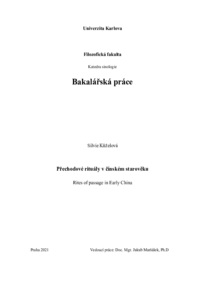Přechodové rituály v čínském starověku
Rites of passage in Early China
bakalářská práce (OBHÁJENO)

Zobrazit/
Trvalý odkaz
http://hdl.handle.net/20.500.11956/150450Identifikátory
SIS: 230404
Kolekce
- Kvalifikační práce [24991]
Autor
Vedoucí práce
Oponent práce
Zádrapa, Lukáš
Fakulta / součást
Filozofická fakulta
Obor
Sinologie
Katedra / ústav / klinika
Katedra sinologie
Datum obhajoby
6. 9. 2021
Nakladatel
Univerzita Karlova, Filozofická fakultaJazyk
Čeština
Známka
Výborně
Klíčová slova (česky)
Čína|starověk|rituály|přechodové rituály|iniciace|svatba|Yili|Zuozhuan|Liji|Arnold van GennepKlíčová slova (anglicky)
China|Antiquity|Rites|Rites of passage|Initiation|Wedding|Yili|Zuozhuan|Liji|Arnold van GennepBakalářská práce se zabývá přechodovými rituály v čínském starověku, a to primárně na základě ritualistického spisu 儀禮 Její obecné teoretické východisko představuje především popis přechodových rituálů, tak jej ve své klasické monografii podává Arnold van důrazu, který je v kladen na strukturování a utváření společenských vztahů, je při analýze průběhu přechodových rituálů věnována hlavní pozornost jednotlivým ukazatelům, které charakterizují sociální role účastníků obřadů a jejich vzájemné vztahy, stejně jako jejich proměny v průběhu obřadu. do širšího kontextu v dalšími písemnými prameny, především spisem 禮記 左傳
The bachelor's thesis deals with rites of passage in Chinese antiquity, primarily on the basis of the ritual text of Yili 儀禮. Its general theoretical framework is description of rites of passage as given by Arnold van Gennep in his classical monograph. Due to the emphasis which Yili 儀禮 places on the structuring and formation of social relationships, the analysis of the course of rites of passage focuses on individual indicators that characterize the social roles of participants and their relationships, as well as their changes during the ceremony. The results of the analysis of the Yili are then placed in a broader context in confrontation with other written sources, especially the ritual text of Liji 禮記 and the Zuozhuan 左傳 chronicle.
